While the series has seen many changes from its first game in 1994 to its most recent in 2011, it has also stuck to its open-ended roots as "be anything you want, do anything you want", exploration-oriented adventures. The goal of this post is to pick two games in the series and examine how the titles have changed over time.
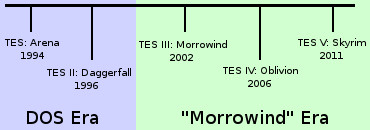
The two games that were selected were The Elder Scrolls II: Daggerfall, and The Elder Scrolls V: Skyrim. The reasoning for this is that the series can really be split into two categories, with Arena and Daggerfall being lumped together-- both were DOS games, both used many of the same graphical and audio assets-- and the latter three being grouped as "Morrowind and its clones"; Morrowind re-invented the series with a new game designer, a modern 3d engine, and dramatic accessibility tweaks to the formula, while Oblivion and Skyrim simply followed suit. Thus, it makes sense to pit the so-far "final" representations of both branches against each other.
Character creation and stats - Advantage: Daggerfall
Creating a character in Daggerfall is an incredibly robust and customizable experience, and at each step there are possibilities to let the game roll a character for you. If the player chooses to do all of the steps manually, here is the extent of the possibilities:
- Select a race by clicking on one of eight regions on the map (clicking on "Imperial Province" doesn't do anything)
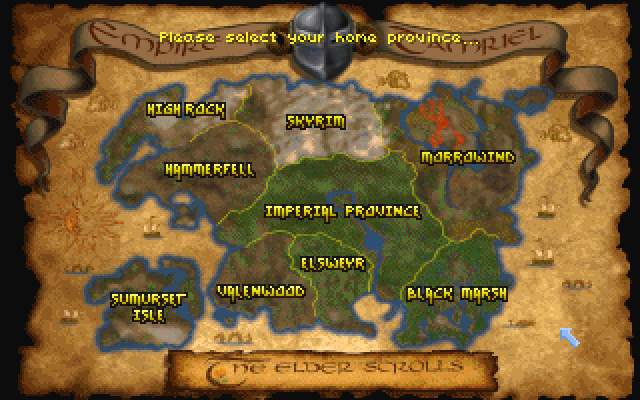
- Select a sex
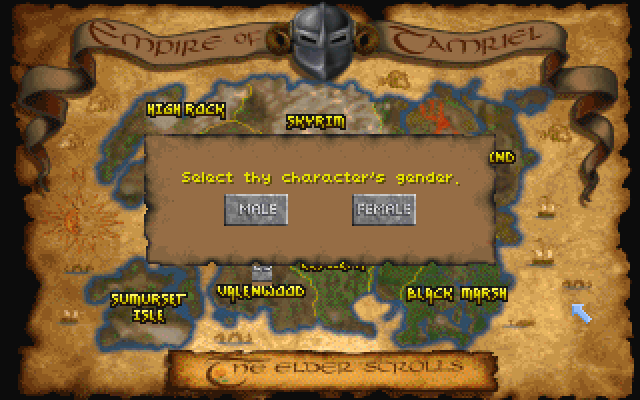
- Choose how you want to generate your class, including a full manual option (on which the steps subsequent to this one are based), by picking from one of 18 pre-defined classes, or by answering a series of questions, after which the game will make a recommendation of its own
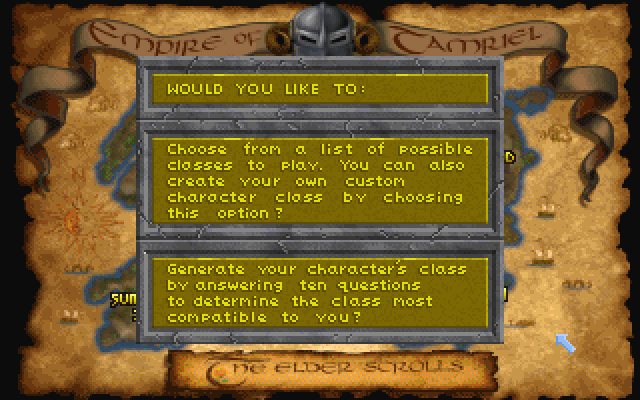
- Using the class builder, you trade points among the core stats (strength, endurance, intelligence, etc.), select your primary, major, and minor skills from a huge list of possibilities...
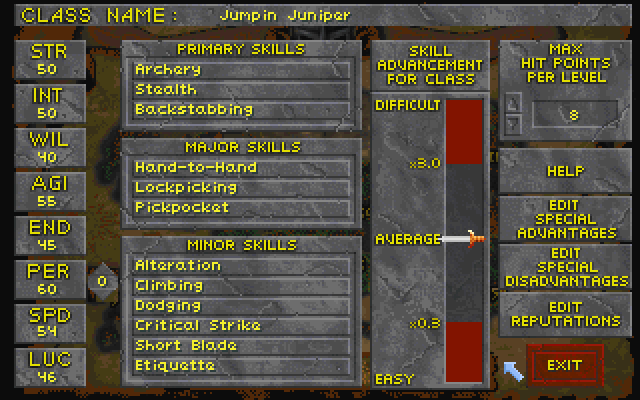
- ...and even add special advantages or disadvantages. Want to make a vampire class? Or a werewolf class? Or a superman class that's however too stupid to know its own name? Go ahead!
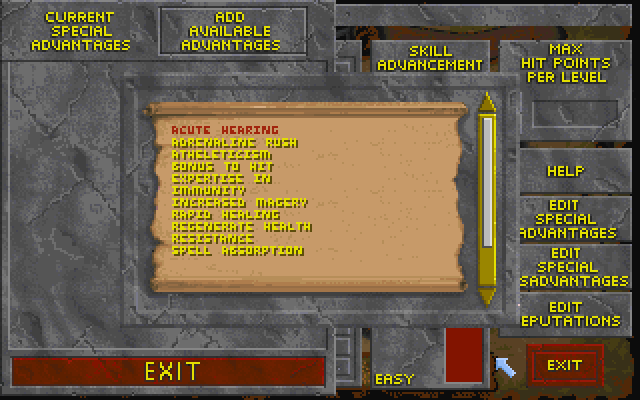
- You can also configure your starting reputation with the game's various factions
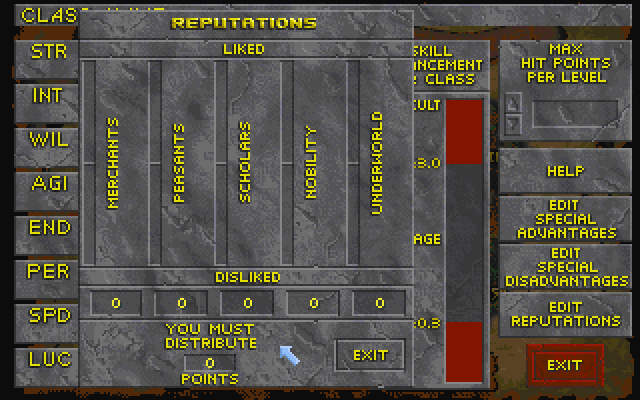
- Depending on which advantages or disadvantages you select, it will be easier or more difficult for your character to level up, as seen by the "Skill Advancement for Class" slider
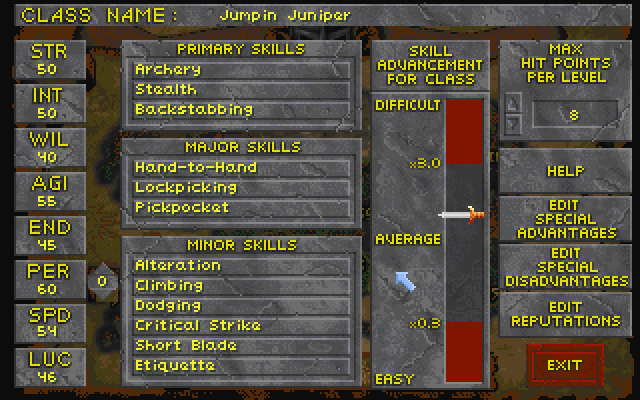
- Finally, you pick a name, a face from several presets, and how fast you want the combat to be-- a factor that also impacts player the rate of player level advancement
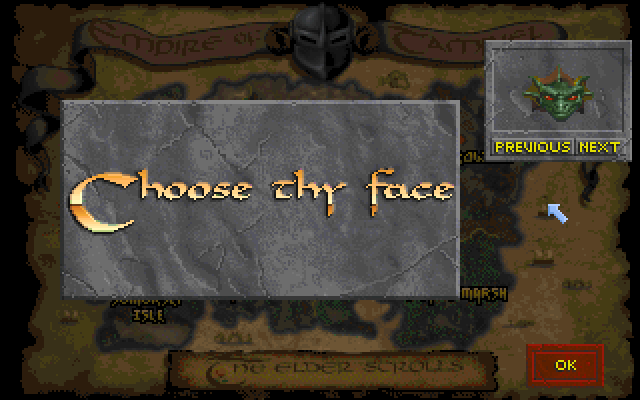
By contrast, creating a character in Skyrim is quite different:
- You watch a lengthy, unskippable cinematic
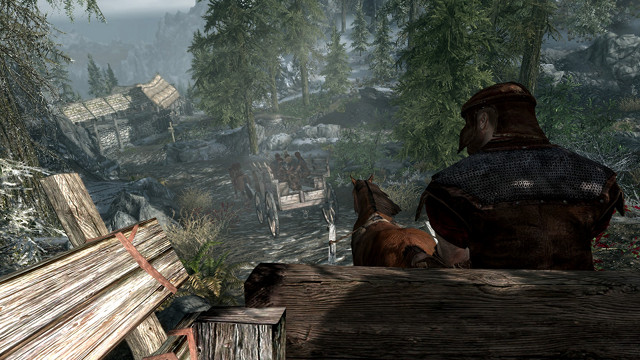
- Pick from one of ten races
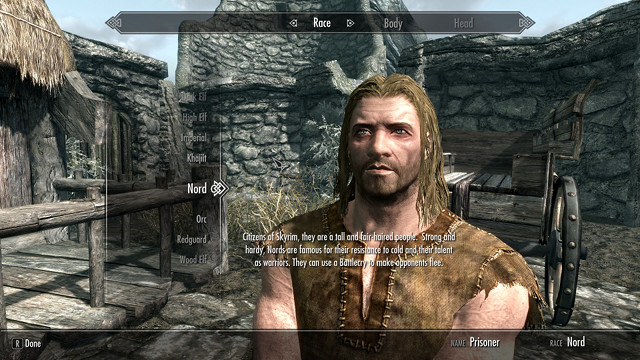
- Configure just about every aspect of your character's appearance, right down to the shape of the bridge of their nose
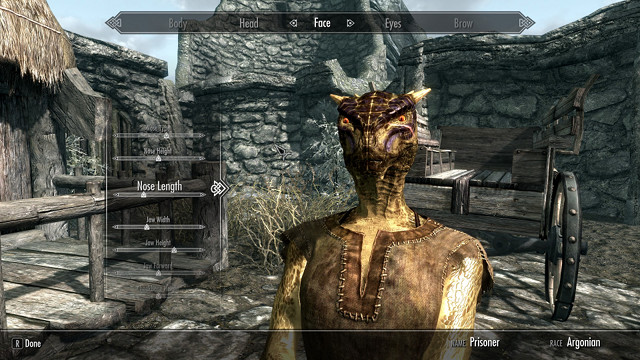
- Enter the name of your character
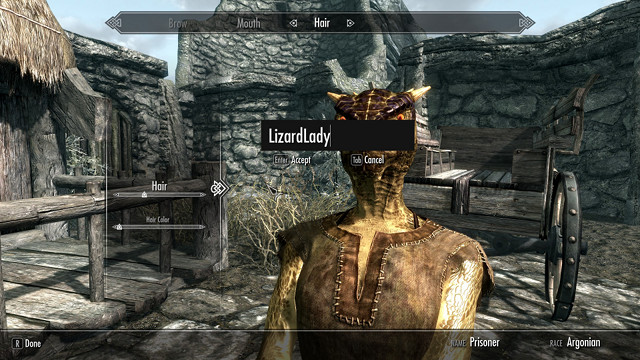
You may be wondering then at what point you roll your stats and select or define your class. In Skyrim, unlike almost every other CRPG ever made, there are no stats (strength, dexterity, etc.). And there is also no concept of character class. Instead, you simply get good at whatever skills you use, and you select various special abilities-- like the "Perks" in the Fallout series-- as you increase your ability in these specific skills. Examples of these special abilities are charging critical strikes, the ability to make double-strength healing potions, or the ability to cast stronger illusion spells.
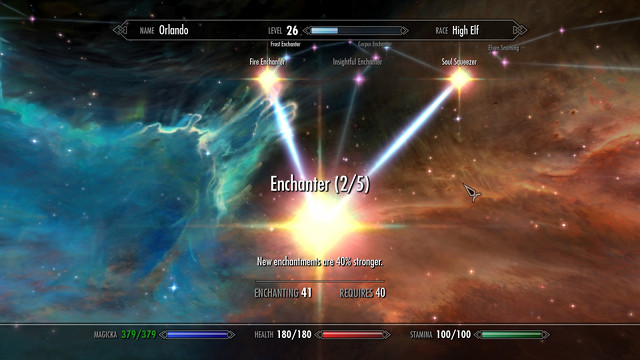
While it might seem superficially more representative of the actual world that one gets better at the things one endeavors to practice, in reality people have inherent strengths and weaknesses from the minute they were born (think Myers-Briggs and multiple intelligence measures). And in game terms, picking up an axe and a bow in quick succession at the beginning of the game and finding that your character can yield either with equal ability feels downright silly. As such, eschewing classes feels like a cop-out to make people ordinarily uncomfortable with CRPGs feel more at home. Unfortunately, this route sacrifices the "bread and butter" CRPG crowd that appreciate the incredible depth and flexibility offered by a class creator such as Daggerfall's.
Aesthetic - Advantage: Daggerfall
Aesthetics are the most subjective aspect of this particular analysis, but the case can easily be made that Daggerfall is better at what it sets out to do than Skyrim is.
Like most 3d games from 1996, Daggerfall's engine makes use of relatively primitive geometry and low-resolution textures. On its face this would seem to be a negative thing; more is better, right?
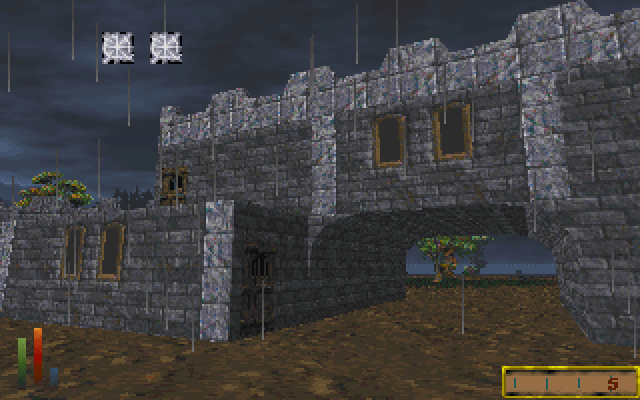
Well, there is something inherently "video gamey" about pixel art-- after all, it is pixels upon which the entire concept of a video game is based. As resolutions have increased, the emphasis on the "pixel aesthetic" has diminished in use, but hardly in appeal; one need only look at the hundreds of contemporary pixel-art focused indie games, or at the incredible popularity of a game like Minecraft, which looks a lot like a direct mid-90's peer of Daggerfall, to see that the art style is still extraordinarily popular.
With regards to Daggerfall's implementation of this "pixel aesthetic", it's a mostly positive mixed bag; the texture work in the towns and dungeons is fabulous; the primitive lighting model in particular really lends itself well to representing creepy dungeons and booming metropolises. The character art, however, is positively dreadful, especially when the discussion turns to the downright disturbing looking townspeople.
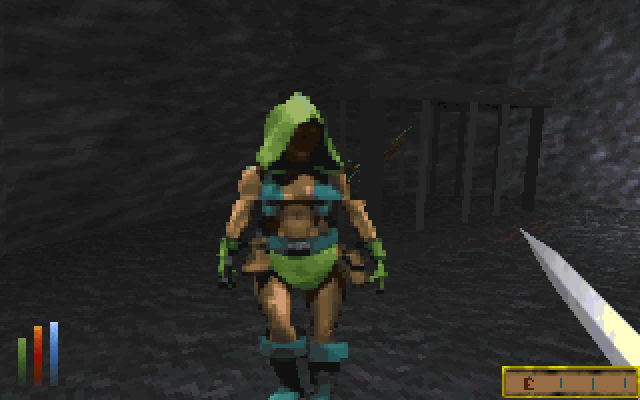
But in a way, the bad character art fits the game's curious sense of humor; the game is positively littered with witty dialog and funny text prompts. Heck, the Khajiit come from a place called "Elsweyr"! The dark-yet-humorous bent then flows into the gameplay itself, making the ludonarratively interesting setting just that much more distinct.
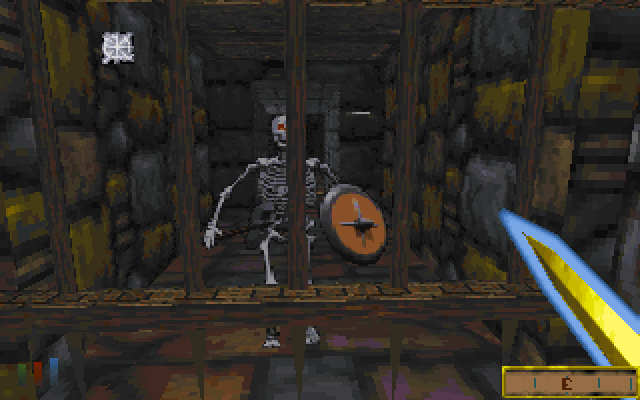
Skyrim, on the other hand, goes for utmost seriousness and realism; the opening sequence plays out like a scene from a Hollywood film, and the game is spent listening to NPC Arnold Schwarzenegger-soundalikes spewing the most dramatic dialog one could possibly write. Hearing one of these NPC exchanges reference the aforementioned "Elsweyr" in a serious tone brings to the surface just how far the Elder Scrolls games have strayed from their earlier light-hearted demeanor.
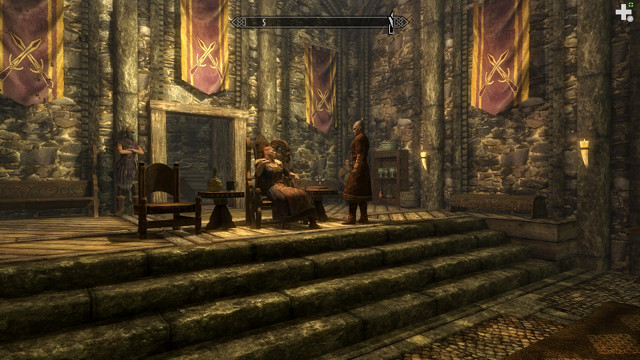
As for the visual aesthetic, Skyrim tries so hard to be realistic that it overshoots its target completely and winds up being utterly monochromatic and unrealistic; the entire world, especially during night time, is almost totally black and white-- like watching a film from the early 20th century-- and the character's pupils are wildly dialating and undialating as the player looks at lighter or darker things.
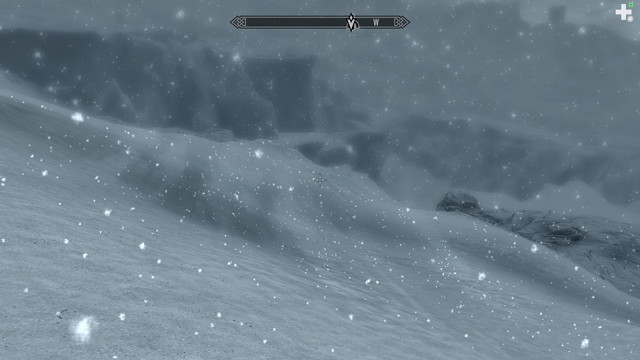
You do occasionally get some "purple mountain's majesty"-type moments in Skyrim, which can truly be stunning. But there's no reason why the aesthetic has to be so weary the rest of the time.
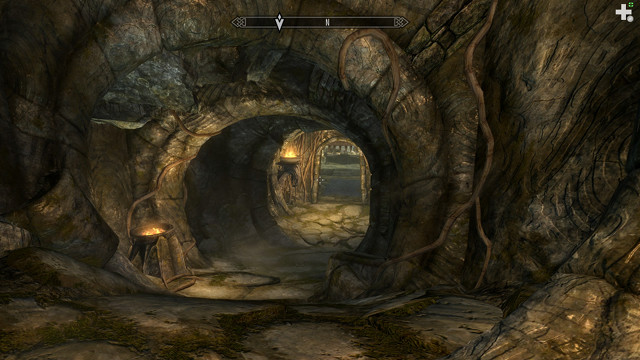
World and dungeon design - Advantage: Skyrim
Like Arena before it, Daggerfall's world and dungeons were procedurally generated, then hand-massaged and stuck into the game. The advantage of this approach is that it allowed for a staggering scope; indeed, Daggerfall's landmass is 219,654 square kilometers-- versus real-life England, which is 130,395 square kilometers. The world contains 15,000 towns, cities, and dungeons which can be fast travelled between at any time. In fact, the game world is so vast that the world map has a search function, which is absolutely essential.
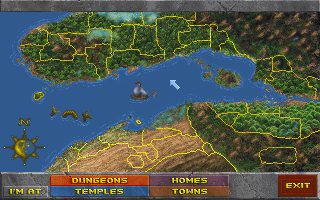
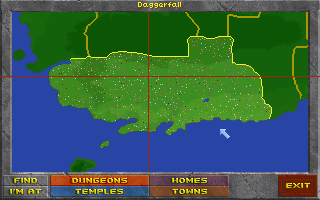
The towns and dungeons themselves are stunningly massive; wandering the former feels like walking around a full-scale New York City, while in the latter it is extraordinarily easy to get hopelessly lost.
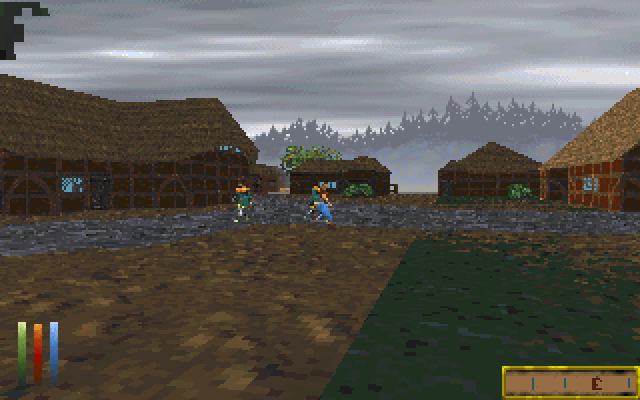
Like everything else in Daggerfall, even fast travel has a plethora of features, so many that you actually fill out a form upon selecting your destination!
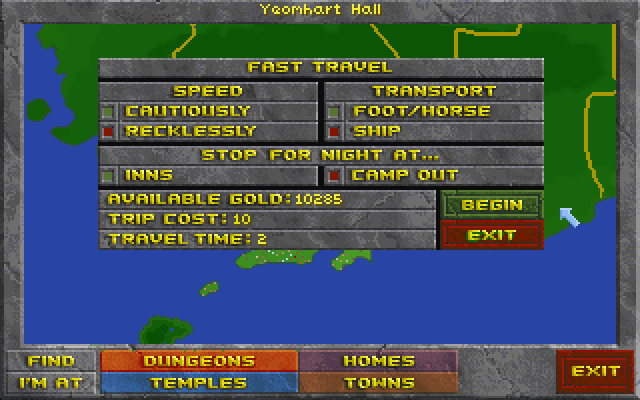
There are some issues with this procedural approach however; all of the towns and dungeons more or less look exactly the same, as do the hundreds of NPCs occupying each town. Since the world is so huge, the player never really even sees any of it, since fast travel is the obvious mechanism for moving from place-to-place. On the one hand this does make for a game high on endless replayability-- the player will never run out of towns and dungeons to explore. On the other hand, the exploration isn't particularly satisfying since everything is so uniform.
In an entirely different approach, Skyrim's world was completely hand-crafted. As such, it's 37.1 square kilometers-- put another way, you could fit 3500 of Skyrim's maps into the Daggerfall world! Exploration is hardly everything, but Skyrim can definitely claim that its world, towns and dungeons are infinitely more interesting to investigate simply for the sake of investigation.
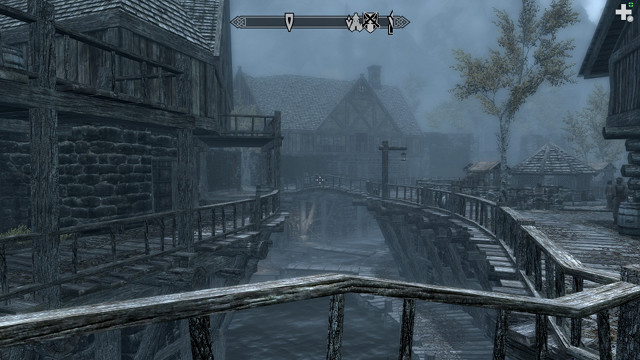
Where Skyrim falls down a little is in details of its map; a great game teaches the player mechanics without them realizing it. For instance, the first map in Super Mario Bros. 3, through sheer element placement and subconscious cues, lets the player learn the game's nuances without them even realizing that they've been led.
Morrowind's world did this exquisitely; it's as if the designers thought to themselves at practically every square foot, "what visual cue can I put in all directions to 'steer' the player towards what will make the game the most fun for them?" Skyrim's world, not so much; it's essentially endless tracts of snowy hills, rivers, and the occasional field of trees. In a way, the game suffers the same disease as Daggerfall; you essentially just fast travel towards where you need to go, and manually travel by foot only when absolutely necessary.
Even so, there is no doubt that Skyrim's world is more interesting than Daggerfall's, even if the former's isn't the epitome of open world map design. And as for Skyrim's dungeons, they can be genuinely entertaining; each one does have a hand-tailored feel to it, and some even have fun little narratives-- delivered in the form of props and letters that the player can pick up and read-- woven into them.
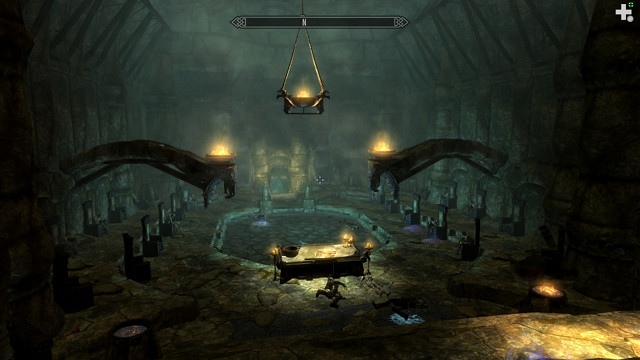
Combat - Advantage: Skyrim
There are two competing schools of thought when it comes to combat-- one group thinks that a "hit" or a "miss", damage a spell should do, and whether a "block" works or not should be determined by statistics. After all, this is an RPG we're talking about. The other camp would prefer fully real-time, reflex-driven combat.
Both Daggerfall and Skyrim make attempts to appease both crowds, albeit with Daggerfall skewing more towards the stat-driven approach, and Skyrim leaning towards the action-oriented approach.
Back in the character creation section it was mentioned that in Daggerfall you could choose the speed of the game; a slower speed means that it takes longer to level up, while a faster speed means that leveling up occurs more quickly. The idea is that young'uns will choose a faster speed, while older players more interested in adventure than action will choose a slower setting.
In the end though it doesn't make a whole lot of difference, since either way connecting a blow in Daggerfall is dependent 100% upon stats. This in and of itself is fine-- most RPGs are stat-driven-- but where Daggerfall's combat falls down a bit is in magic use.
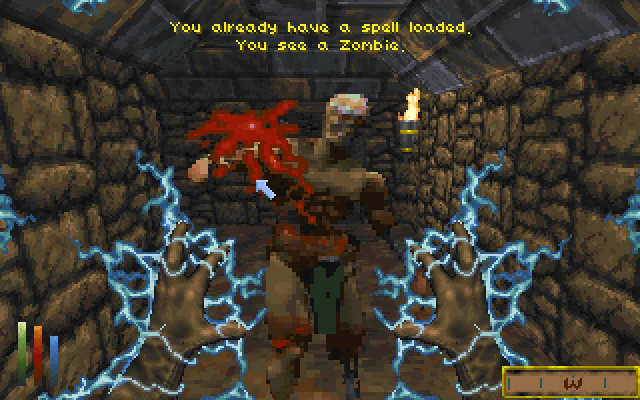
First off, even when selecting an INT multiplier during character creation, so as to maximize the amount of mana available, the player can only use a combat-oriented spell a few times before their mana is exhausted. And unlike in Skyrim, mana replenishes very slowly-- so slowly that the only realistic way to replenish it, outside of a potion of course, is by resting. And one can only rest when no enemies are nearby.
Further, casting a spell in Daggerfall is bizarrely complicated. First, the player must open their spellbook and select a spell. Then they must toggle into "cursor mode" so they can click on the target. Then they must hit the actual "cast spell" key to perform the attack. If facing more than one aggressor, the player must quickly toggle between "cursor mode" and "free look" mode as necessary to maneuver in combat. Essentially eliminating magic from Daggerfall's repertoire means that every confrontation devolves into a "slash, step backwards, slash, step backwards", and so on, until the enemy is dead. And if one does choose to use combat magic, the combat becomes very static indeed, and unnecessarily planful (only because the control scheme is so convoluted).
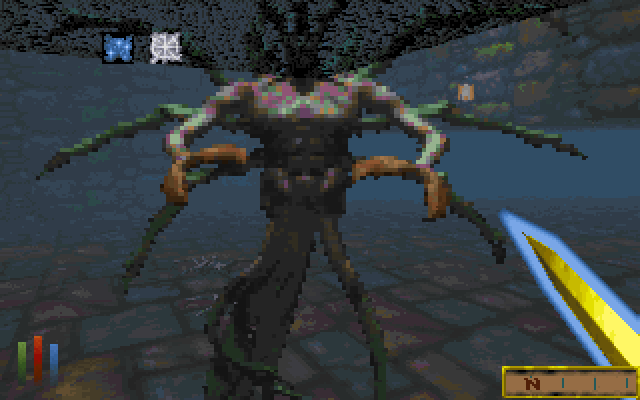
There are several different kinds of slashes at least, performed by holding the attack key and moving the mouse in the direction of the desired slash.
Skyrim's combat, by contrast, is much more intuitive and fluid; the player is often facing numerous aggressors all at once, and since the scenery is so much more complex, there is a kind of ludonarratively-interesting dynamism happening. Additionally, the player can equip a weapon or spell to each of left and right hands simultaneously-- this opens up lots of possibilities, like having an "attack" hand and a "healing" hand, dual-wielding fireballs or swords, or having a sword and a shield or a spell and a shield.
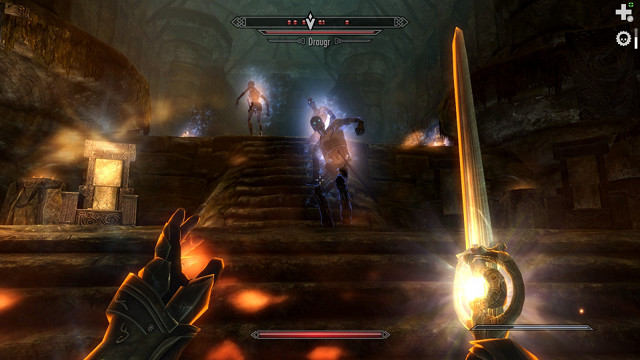
There isn't much in the way of stat crunching going on during Skyrim's battles, and there really isn't much in the way of variety in the combat spells-- one can utilize ranged, melee, or "mine"-style versions of fire, electricity, and ice-oriented selections-- which is unfortunate given that the potential for ludonarrative excellence is otherwise quite high. But all the same, Skyrim's combat is definitely more interesting than Daggerfall's.
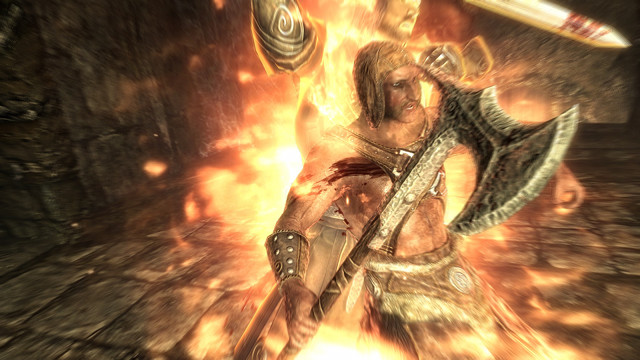
Pacing and the progression of power - Advantage: Daggerfall
Ever since Miyamoto introduced Super Mario Bros. in 1985, in which progression was defined by reaching the "end" of the game, games have become more and more explicit-narrative driven, even to the point of being like mini-Hollywood movies, replete with voice acting and dramatic orchestra music.
Players that enjoyed the over-the-top emotionalism and drama of the recent "Lord of the Rings" films will infinitely prefer Skyrim to Daggerfall; the quests are all voice-acted, while many are highly scripted, and high on splashy explosions and drama. And as mentioned earlier, the game takes itself oh-so-seriously, which might sit well with an audience typically too impatient to play an RPG in the first place.
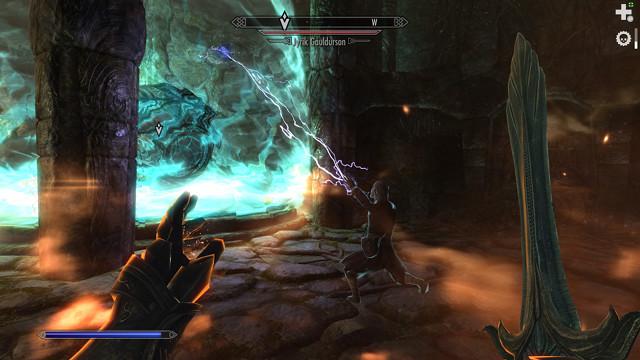
Daggerfall, by contrast, is oriented around infinite replayability; even though the world map and dungeons aren't the most interesting in-and-of themselves, it's easy to get into a certain rhythm of progressing slowly-but-surely through the ranks of the game's incredible number of factions by completing quests. The templates for the quests become familiar after a time, but that's a big part of the fun-- learning the nuances of the different quest types and doing them as efficiently as possible becomes a sort of metagame on top of the game itself.
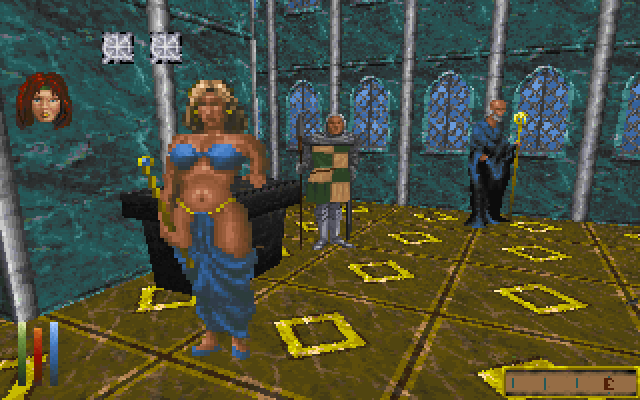
Further, part of the fun of playing an RPG in the first place is that the player feels more and more powerful as the game plays out. Much of this sensation is lost in Skyrim, in part because the combat is more action than stat oriented, in part because there are no character stats to speak of-- only "perks"-- and in part because the player can use any ability at any time, since there are no character classes.
In Daggerfall the sense of character power is palpable; being able to take on a Vampire Ancient-- which can one-shot the player for the initial 20-30 hours of play-- for the first time, while being able to one-shot previously formidable foes, lends a very definite sense of progression.
Which game is more fun - Advantage: Daggerfall
Players that prefer a more arcade-like or cinematic experience will infinitely prefer Skyrim. For players versed in the art and science of playing in-depth RPGs however-- especially if said players like the 90s-style pixel aesthetic-- Daggerfall is a truly wonderful, memorable, and infinitely replayable experience.